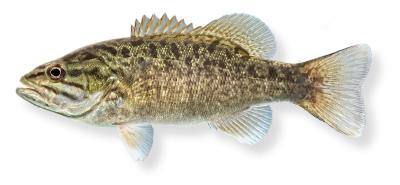Smallmouth Bass
Micropterus dolomieu
 Distribution: Smallmouth bass are native to the Great Lakes and Mississippi drainages of the central United States. They were introduced into New Hampshire in the mid 1800’s and are now widespread.
Distribution: Smallmouth bass are native to the Great Lakes and Mississippi drainages of the central United States. They were introduced into New Hampshire in the mid 1800’s and are now widespread.
Description: The smallmouth bass is a member of the centrarchid, or sunfish family. More streamlined than many of its relatives, the smallmouth is well adapted for living in either flowing or calm water. The mouth of the smallmouth bass does not extend past the eye, as opposed to the largemouth bass, whose mouth extends past the rear edge of the eye. Smallmouth bass tend to be olive green to bronze in color, with vertical markings that become blotchy with age. Largemouth bass have a more greenish tint, with a horizontal, sometimes broken, black band that runs along the length of the body. There are small scales at the base of the dorsal and anal fins of a smallmouth bass, while those of a largemouth bass are scaleless. Juvenile smallmouth bass have distinctive tri-colored tails: orange and black with white at the tip.
Species commonly confused with: Largemouth bass
Habitat: Smallmouth bass prefer clear, rocky areas of lake and pond shores or medium sized to larger rivers.

Life History: Smallmouth bass take advantage of boulders and fallen trees as cover, from which they ambush prey including small fish, crayfish, and insect larvae. They are less tolerant of warm temperatures than largemouth bass, and tend to move into deeper water during the summer. Smallmouth bass spawn near shore in the spring when water temperatures rise above 15°C (59°F). Males aggressively defend a nest containing the fertilized eggs of multiple females. Males will continue to defend the fry after they emerge from the nest, moving in a school for about a week before they disperse. Smallmouth bass are extremely popular with anglers as a strong fighting fish prone to leaping from the water when hooked.
Origin: Introduced
Conservation/Management: Smallmouth bass are voracious predators with the potential to alter the food webs of freshwater ecosystems. The spread of bass throughout the northeast has resulted in the loss of many native minnow species from lakes and ponds. Smallmouth bass may also compete with native predator fish, such as brook trout.
Smallmouth bass have become naturalized in most New Hampshire waters, where they have become very popular with anglers. Their eradication is neither possible nor desirable. However, further spread of bass should be prevented to protect the remaining habitat for vulnerable native fish species.



